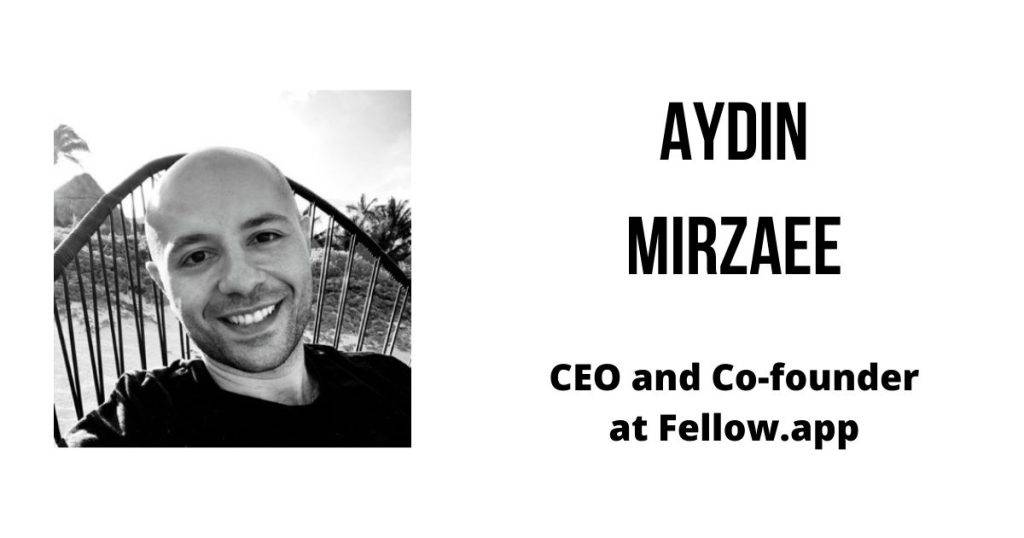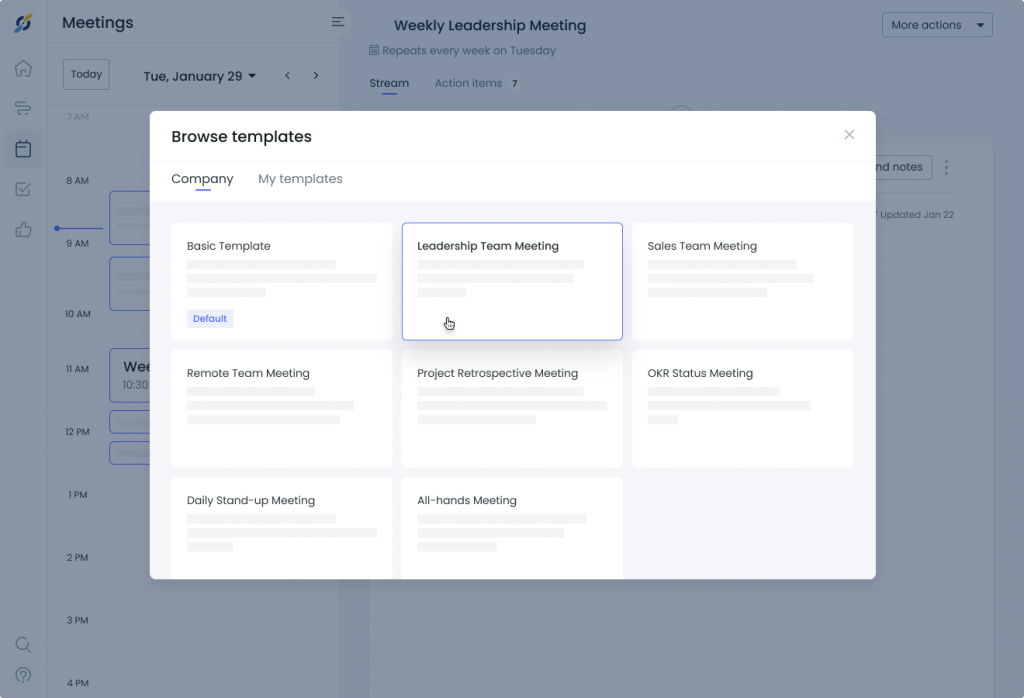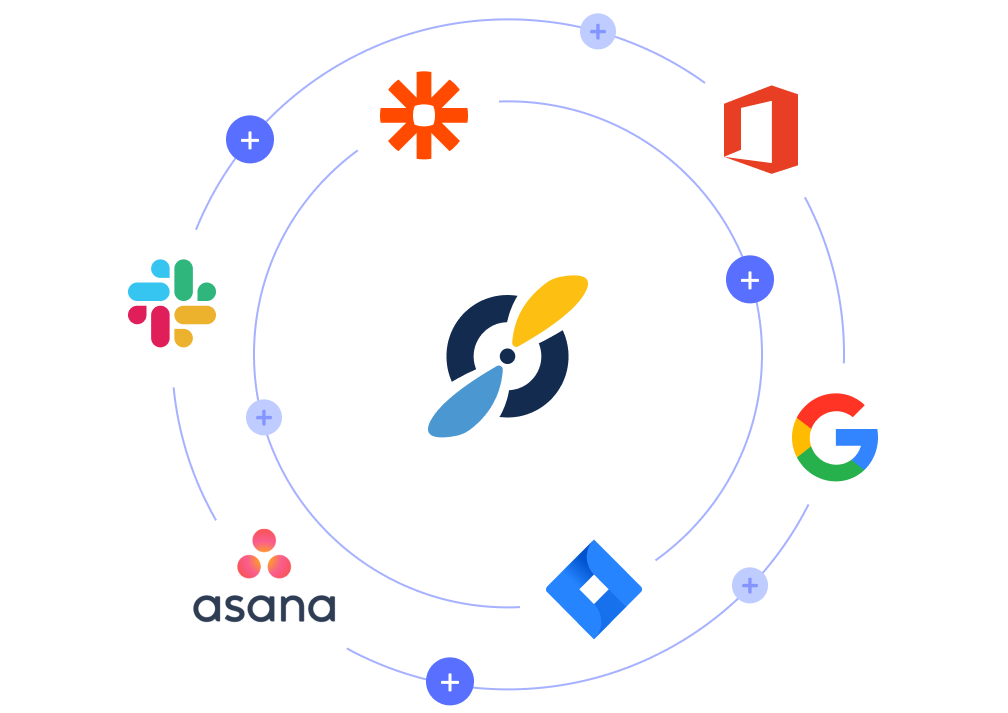Meetings – love them or hate them, but you can’t ignore them. Every organization, big or small, has a lot of meetings between teams, managers, and their departments, and so on. Yet, a lot of meetings don’t result in execution. The Canada-based Fellow believes it can change the paradigm by ensuring that everybody who’s joining the meeting is prepared. Even after the meeting, everyone knows what needs to be done. We recently got a chance to interact with its CEO and founder Aydin Mirzaee whom we met at the SaaS North conference.
PS: The interview has been edited for the sake of brevity.

Table of Contents
1) Before we begin talking about Fellow.app, our readers would love to know your journey into the world of SaaS?
He replied “my journey into the world of SaaS started back in 2008. I had a company before Fellow, and the company was called Fluidware, and we had two products. But one of those products for which everybody knew us was called FluidSurveys. It was an online survey tool. This was at a time where, most people were professional survey users. So some people would use a product like SurveyMonkey, but most people were using very legacy old school enterprise software that you would actually install on your servers. So you know, you could do some of the basic things with tools like SurveyMonkey, but if you wanted to do something really advanced, you’d be going to more kind of a legacy enterprise software. And that’s where FluidSurveys came in. We built this kind of online survey tool that had a lot more of the advanced features that you’d expect in these enterprise-grade survey tools that you’d install on your servers. That’s where we started in 2008. It was a bootstrapped company and we grew it to about a hundred people or so, and over 10million in annual sales run rate. We sold it in 2014, since SurveyMonkey wanted to kind of get into the enterprise survey space and we were kind of the gateway to help make that happen. You could argue that SurveyMonkey almost invented SaaS, for they were so early in the process back in 1999, when they first launched.“
“I always wanted to take part in the movement of turning old desktop software into web-based software. And it was really interesting for me for a number of reasons: one of them was that it was a different school of working in the sense that like in the past the model was that you’d basically take software, and sales folks would kind sell the software and oftentimes, it would never get installed. And the difference with SaaS was it was very much about like every year, you’re voting with your wallet, whether or not this service delivers enough value in comparison to what it’s charging. It made sense from the consumer standpoint, and it was new and cool because you could make updates all the time. It’s been 12 years that I embraced the world of SaaS and it still continues to fascinate me,” he added further.
2) What insights led you to the launch of Fellow.app?
He straightforwardly mentioned that “SurveyMonkey had a lot to do with it. In fact, I kind of describe my entrepreneurial journey – in the world before Survey Monkey and at Fluidware, where I was learning entrepreneurship, learning how to be scrappy, learning how to move fast, and make things happen, and post-SurveyMonkey, which was a different sort of world. At Fluidware, we didn’t have a board and it was my co-founders and me, who were making all the decisions. We didn’t like to do things like plan a year ahead. It was always month over month. For instance, when we had extra cash in a month, we decided to hire some people. We didn’t really have a finance department or legal. It was a kind of very flat organization. And even though we were brushing up close to a hundred people, it kind of operated in that way.“
Adding to that, he shared “once we got into the world of SurveyMonkey, which was a larger organization and we kind of grew with them. We were about a third of their staff when we were acquired and afterward, we grew to over 800 people with them and today, it’s much larger, and they IPOed, and I think they’re, well over 1,200 people today. So I learned how all the different functions that come with scaling an organization and managing a team. And we ran into these concepts of like how remote teams work because we had many different offices. So I got exposed to a bunch of different things. And what was interesting is my co-founders and me kind of looked at this and we said, there’s software for every class of the company. So basically every division, whether it’s marketing and sales, or finance, everybody’s got their own tool? For marketing, maybe you have a HubSpot for Salesforce. So the question that we asked was when you’re starting to run a team, when you become a manager, when you become a leader, where is that equivalent tool? So Salesforce for account managers. HubSpot for marketers. Like what about just people managers? And we just thought that there was a gap in the market. And we really got into it in the beginning when we kind of thought let’s go out and build this manager’s co-pilot. That was the original idea behind what we wanted to do at Fellow.“

“Based on that, we all left SurveyMonkey to start this company. But of course, once we started building, we said what are the things that managers do? And you know, the thing that occupies the most of their time, it turns out is meetings. So we got really obsessed and passionate about meetings and we said they spend most of their time in meetings. And everybody’s complaining, nobody likes their meetings as everything is disorganized. It’s this big problem that’s persisted forever. Why don’t we tackle that problem? So that’s kind of the philosophy? When you go to our website, the tagline reflects that: great meetings are just the start. We wanted to do more than just meetings and we are more than just meetings. But the thing like the narrow problem that we’re starting to solve is this meeting problem. Every knowledge worker in the world has this problem. It’s a big problem. And the goal that we like to say is that we’d like to turn the chaos of meetings into productive work sessions. That’s really the philosophy and that’s where Fellow has gone, and it’s like so relevant today. Especially with ever more distributed teams, where you have to be so purposeful about your communications. You’re on Zoom calls the whole day. And so the question is how can you prevent those meetings from being a waste of time? And so that’s the thing that Fellow helps with is to make sure that every meeting that you attend is worth showing up to,” he added.
3) Can you share the evolution of Fellow.app since its inception in 2017?
Mr Aydin Mirzaee told us that “we incorporated the company in early 2017, but we had to pivot somewhere in the middle. So we’ve been working on Fellow probably in its current form for just over two years. The first philosophy was we just wanted to make sure that this was a product that people love because we knew that we could get a lot of people to use it, and we could expose a lot of people to it. But the aim was to make sure that this is a great product and it’s a bottom-up product. Again, going back to the world of SaaS, we really believe in this concept of bring your own software. It’s not like corporate buying something for everybody anymore. Now people choose the tools that they like the most. And the question was whether we can build a tool that some people can bring into their organization, evaluate it, and if it’s good, they’ll talk to their colleagues about it. Then maybe, they’ll take it to corporate and say that this is a really great software that’s changed the way that we have meetings, and our meetings have become awesome. It’s the best part of our day because of Fellow and so we think that this is really great for the whole company. That’s kind of what we wanted to build.“
He added that “we started with some customers in the early days. We asked ourselves if some world-class companies would want to use Fellow, and so we approached folks at Shopify, and they agreed that a small team of like five to 15 people would evaluate and try this product. So they did, and the first versions that we had weren’t great, but we iterated, and we kept making it better. And then eventually we got to this point where it just started to spread within the company. There were like 10 people and then 20, and then 100, 300 and 500, and eventually they were like, okay, let’s use this across the company. So today we have well over 5,000 active users at Shopify. Similarly, at other companies, our next step was to make sure that this works at all types of companies. And then we went out and got other customers, early customers like Vidyard and Time Doctor. Once that model got proven, our next step was like, let’s get to a point where we can, we can show that this works on a bottom-up basis. So we were on a waitlist for a very long time. Like you joined this waitlist and we progressively let people in and to use the product and we just kept making it better and better. Then in September 2019, we finally came to general availability. So just over a year ago, we launched version 1.0 of Fellow to the public that anybody could sign up for. Then we got to a point where we launched the v2 in August this year. On November 19th, we’ll be launching Fellow version 2.1. I’m not going to say too much more about it because we want it to be a surprise, but lots of great things coming on that front too.“
4) What’s the current user base of Fellow, and what kind of industries are your biggest customers? What are the biggest markets for you?
Being upfront, he shared “here’s the thing: everybody has a vision or thinks like something’s going to turn out a certain way when they start a company. My original thought was that this is going to be one of those products that companies that are like 50 to 500 people would be using. And it’s probably going to be very tech-oriented. Once we started really promoting Fellow, it’s really strange, while we do have a lot of software-focused or knowledge-based workers and have very large companies with tens of thousands of people, we also have people who are using it individually. So if you’re just like one person and you just want to have amazing meetings just for yourself, that’s also a great use-case for Fellow, and we have a lot of paying customers for the same. Then we also have churches, religious organizations, non-profits, schools, colleges, and universities too. In hindsight, it makes sense because everybody has meetings. And this concept kind of resonates with all of them. Moreover, once people started using Fellow, they realize that this is going to change the way that they have meetings. But at the same time, it also helps them with so many other things like managing their teams. And so that’s kind of what happened. Pandemic has also accelerated the adoption because most companies thought that once they reach 50 people or more, they need the meeting culture before. But with everybody working from home, even a small team of five needs Fellow.“
“While we’re not disclosing our user numbers, I can say that we’re growing rapidly. These users are spread across 140 countries, with our paying customers being from 15 of them,” he stated explaining the geographical split for its users.
5) How do you stand out from the competition?

He explained “we don’t do the scheduling. We don’t do time tracking. We don’t do any of that stuff. What we’ll do is help you before, during, and after the meeting. So before the meeting, we make sure that everybody shows up to a meeting, is prepared, and has an agenda, we make sure that like your agendas are awesome. We have amazing templates and workflows that you can borrow from sort of other companies. Then once you have your meeting, we make sure you’re taking collaborative notes during the meeting, and everybody’s active and participating. After the meeting, we ensure that everybody’s got their action items that are being tracked. The first thing that you do at the beginning of the meeting is to talk about the action items to make sure that everybody’s held accountable. Then, we help you manage those action items. So now you’re going to a lot of different meetings. You’ve got all these action items, how do you track those? How do you manage those? How do you complete those? Um, and then we integrate with all your different tools. So we integrate with things like Asana, Jira, and Slack, and we’re just about to release it for Microsoft Teams, and we have the Zoom and Google Meet, and all these different things too. So again, like Fellow doesn’t kind of live in isolation. It connects to all the tools that you currently use.”
“For us, the number one competitor today is doing nothing, which is what most people are doing. They just get on a Zoom call and then it’s just chaos. Everybody’s kind of taking notes in a different place, and then we come back and we wonder why we all have different impressions of what really happened. Then, the second class of competitors is people using generic tools like Google Docs, Dropbox Paper, Notion, or something like that to manage meetings. But we’re a purpose-built meeting tool. So we’re going to do that better than any other tool because that’s our hundred percent focus,” he elaborated further.
6) What’s your go-to marketing strategy to reach out to potential users?
He said that “we do a lot; we want to be the thought leaders in the world on managing teams. So we publish amazing content on our blog. In addition to that, we have a newsletter called the Manager TL;DR newsletter. It’s wildly popular, and I call it one of the internet’s best-kept secrets. Every two weeks, we summarize the best there is on the internet in management content. We read it, we summarize it and we send it to your inbox. We also have a YouTube channel, and we post a lot of great management, educational content. We have a podcast that’s been a huge success. It’s called the Supermanagers podcast, and we’ve had amazing guests. When we started that, it was an idea and people have been so helpful, it’s kind of like the tide is turning and everybody’s coming to us to want to be on the show. We run manager chats on Twitter. We run AMA with famous authors or thought leaders. We do launch events, we do a lot of things. So it’s all about thought leadership around management and managing teams and running meetings.“
7) How has the ongoing pandemic affected Fellow.app – in terms of business, strategy or otherwise?

Mr Mirzaee shared “as a company that uses Fellow, we had no problem going remote. Again, like we think that this kind of accelerates the need for Fellow. Zoom is great. Zoom plus Fellow is amazing. Google Meet is great, but Google Meet plus Fellow is incredible. And now that everybody’s on these meetings, the use of a product like Fellow is more important than ever. We used to have this objection from people when we used to show them Fellow and they’d say this assumes that everybody is going to have a laptop, and everybody’s going to walk into a meeting and they’re going to have this thing open at the same time. Is that what you want? Do you want staring at their screens or do you want them looking at each other? That objection in itself has completely gone away. The world has really started to favor what we’re doing and we’re very excited about it.”
8) What are your favorite SaaS products out there?
He mentioned that “we use Slack, we use Figma in the design team, we use Jira for our development staff, we use tools like Canva for some marketing work. These are the top tools that I can think of. I also like the whole Atlassian suite; we use Confluence and so forth.“






